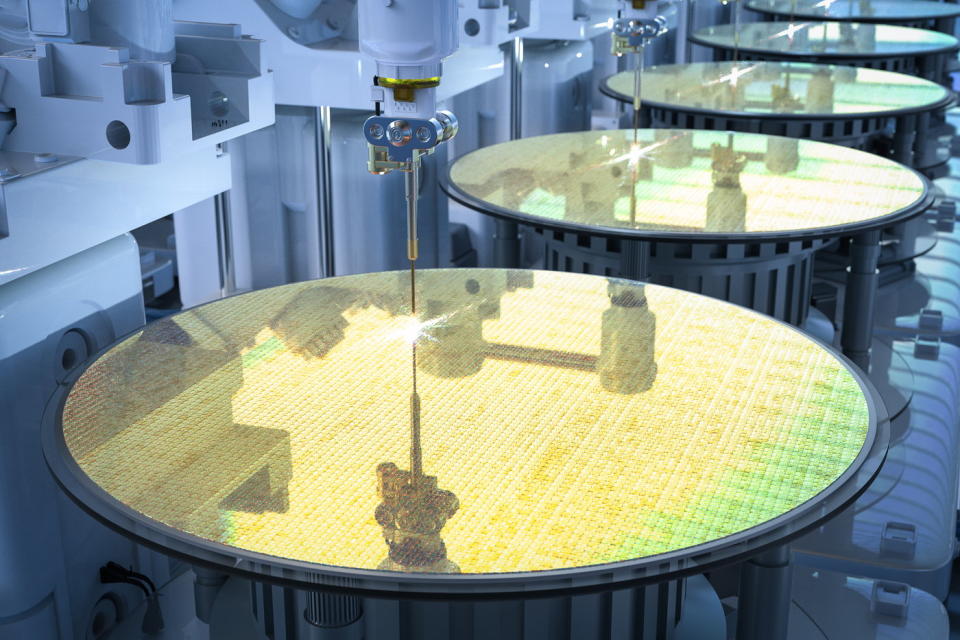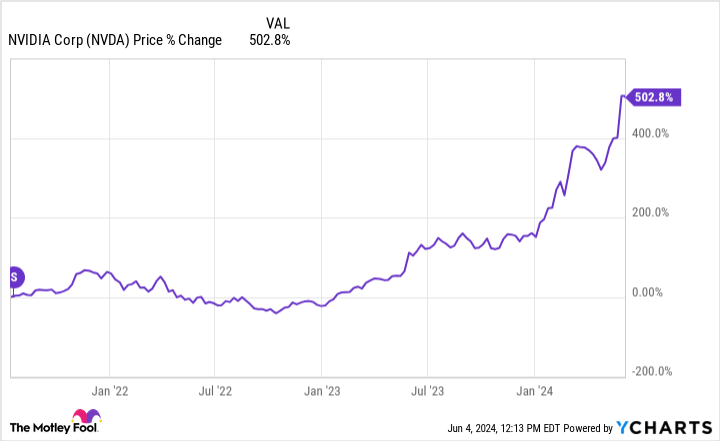There is arguably no hotter name in artificial intelligence (AI) than Nvidia (NASDAQ: NVDA). From specials on 60 Minutes, talking heads on financial news programming, and headlines all over the Internet, Nvidia is everywhere.
There is so much being covered about the company that it’s hard to keep up. One recent update from Nvidia is the company’s upcoming 10-for-1 stock split.
Let’s explore how stock splits work and how they can impact the decision to invest in a company.
1. How do stock splits work?
During a stock split, a company’s outstanding shares rise by the factor stated in the split ratio. Simultaneously, the company’s stock price is reduced by the same ratio.
As of this writing, Nvidia has approximately 2.5 billion outstanding shares and trades for $1,145. If the split were to happen today, Nvidia’s share count would rise by 10 times — resulting in roughly 25 billion shares. Moreover, its share price would be about $114.
Given this dynamic, stock splits do not change a company’s market cap.

2. Why is Nvidia splitting its stock?
In general, the capital markets have performed quite strongly over the last 18 months. Since January 2023, the S&P 500 is up 37%, while the Nasdaq Composite has returned nearly 60%. Much of this performance can be attributed to a bullish sentiment surrounding AI.
When it comes to AI, Nvidia is at the forefront of the tech sector’s next big wave. Shares of Nvidia have risen over 680% since January 2023 and are up about 130% so far in 2024.
Given the sharp rise in price during a relatively short time frame, Nvidia’s stock can be perceived as expensive. Stock splits often occur when management wants to make shares more accessible to a broader base, especially retail investors.
But as I alluded to, stock splits don’t actually change the market cap of a company. Therefore, the lower share price post-split does not mean that you’re actually investing in Nvidia at a more attractive price. In fact, this is seldom the case, and I’ll explain why.
3. How are stock splits handled?
One of the most convenient aspects of a stock split is that investors aren’t required to do anything. Investment firms and brokerage houses handle the details in the background.
Let’s say that you own 10 shares of Nvidia at an average price of $1,000. Following the stock split, your brokerage account will reflect that you now own 100 shares of Nvidia, each at a cost basis of $100.
4. Has Nvidia ever split its stock before?
Nvidia has split its stock five times in the past; the most recent was a 4-for-1 split in July 2021.
Since Nvidia’s last split roughly three years ago, shares have soared sixfold.
5. Should you buy Nvidia stock before or after the split?
Investors spend a lot of time grappling over when to buy and when to sell a stock. The inconvenient answer is that there is never a perfect time to do either. However, there are some things to be on the lookout for when it comes to stock splits.
In general, stock split stocks experience some volatility in the days following a split. Investors perceive the split-adjusted price as cheaper, so they begin pouring in.
This psychological tendency often opens the door to day traders, who ride the momentum and quickly dump the stock for a quick profit. Moreover, this increase in buying activity actually pushes valuation higher — meaning you’re buying into the stock at a more expensive price compared to before the split.
This dynamic can be seen in the chart from the prior section. You can see that for a short period following the split, the share price experienced a brief melt up — only to decline thereafter.
So, should you invest in Nvidia before the split? In my opinion, the exact timing of your investment is not overly important. Spending time in the market is more important than trying to time the market.
Investors should keep a long-term time horizon when it comes to growth opportunities such as AI and Nvidia specifically. Monitoring a company’s progress from both a sales and profitability standpoint over many years is key to generating outsize returns for your portfolio.
Considering AI is in its early innings and Nvidia’s potential within the technology realm in general, I see the stock as a compelling opportunity, regardless of investing before or after the split.
Should you invest $1,000 in Nvidia right now?
Before you buy stock in Nvidia, consider this:
The Motley Fool Stock Advisor analyst team just identified what they believe are the 10 best stocks for investors to buy now… and Nvidia wasn’t one of them. The 10 stocks that made the cut could produce monster returns in the coming years.
Consider when Nvidia made this list on April 15, 2005… if you invested $1,000 at the time of our recommendation, you’d have $704,612!*
Stock Advisor provides investors with an easy-to-follow blueprint for success, including guidance on building a portfolio, regular updates from analysts, and two new stock picks each month. The Stock Advisor service has more than quadrupled the return of S&P 500 since 2002*.
*Stock Advisor returns as of June 3, 2024
Adam Spatacco has positions in Nvidia. The Motley Fool has positions in and recommends Nvidia. The Motley Fool has a disclosure policy.
Here Are 5 Things Smart Investors Should Know About Nvidia’s 10-for-1 Stock Split was originally published by The Motley Fool

Jessica Roberts is a seasoned business writer who deciphers the intricacies of the corporate world. With a focus on finance and entrepreneurship, she provides readers with valuable insights into market trends, startup innovations, and economic developments.









